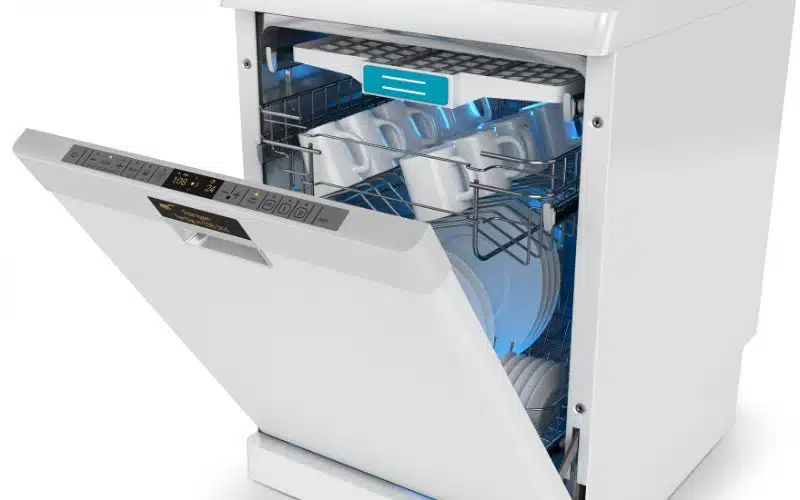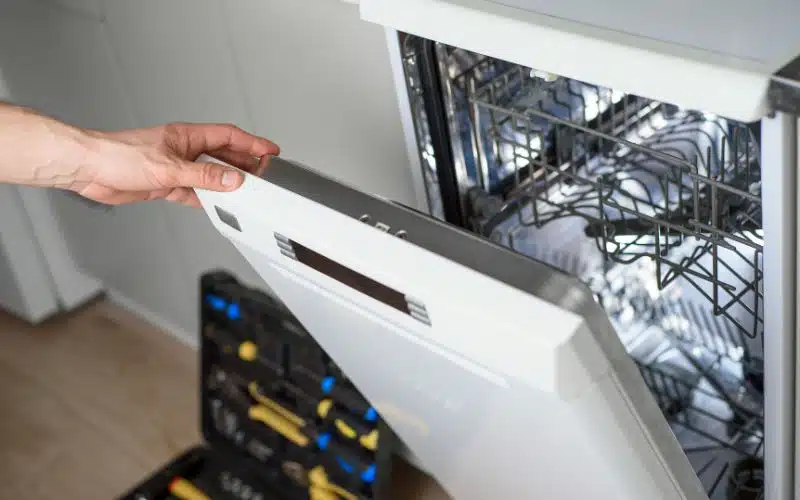It’s needless to say that the dishwasher heating element is a very delicate component.
Any damage to it means the entire dishwasher will not function well. When the heating element is faulty, the dishwasher loses its function.
You get no joy from drying your dishes with a dishcloth after taking them out of the dishwasher. That’s a lot of inconvenience.
So, you must be careful when you clean the dishwasher heating element. No one would fancy using dishwashers when the heating element is faulty. I
t gets annoying using it that way. As with any appliance, you must be sure of what you’re doing before moving to clean any parts. Good intentions can prove costly when you’re executing them wrongly.
The first step to cleaning the dishwasher heating element is taking out the racks. Do that after you unplug the dishwasher from power, of course. Then you need to empty the dish racks and remove them to access the heating element. What follows may be a simple scrub using a toothbrush and lemon juice.
Step by Step: How to Clean Melted Plastic from Dishwasher Heating Element?

Melted plastic on the dishwasher heating element isn’t exactly a rarity. It’s bound to happen to everyone at some point.
Perhaps it slipped your mind that one of your kitchen wares is a softer plastic. Or the smaller plastic ware slipped from the dishrack and fell onto the heating element.
Either way, it’s a mistake that shouldn’t make you beat yourself up. But always ensure to use dishwasher-safe plastic.
The first reaction to melted plastic may be to use a rag or tissue to wipe it off the heating element.
But that ends badly for all parties involved. You may end up with burns on your skin. But not after you succeed in spreading the melted plastic over a wider area of the heating element.
Two easy methods work for cleaning melted plastic off a heating element. One involves some ice, and the second method uses a hairdryer.
That is a prime example of fighting fire with fire, or in this case, a heat wave with a heat wave.
Follow through with either method to clean melted plastic from the heating element.
#1. Ice in a Zipper Bag
For this method, you need the following items:
- A plastic zipper bag
- Ice cubes
- A plastic paint scraper or wooden spoon
- An acetone-based nail polish remover
- Pieces of clean cloth
- Dish soap.
With the items in place, use the following steps to rid the heating element of melted plastic. They are simple steps to follow through.
#1. Turn Off the Power to the Dishwasher
Now, we don’t want the heating element going wild when you’re cleaning it. Do we? You may flick the dishwasher into running a cycle by mistake.
That will result in burns on your fingers. To avoid such a scenario, turn off the dishwasher and unplug the power cord from the outlet. It’s better to be safe than sorry.
#2. Take Out Dishes and Remove the Dish Racks
The heating element and the melted plastic will cool faster with extra ventilation. Taking out the racks also gives plenty of space to clean the dishwasher heating element.
#3. Place Some Ice on the Melted Plastic
Grab the plastic zipper bag and fill it with ice. Ice cubes are preferable so that they don’t melt so fast.
Place the zipper bag filled with ice on the melted plastic for about 30 minutes. The temperature drop will make the melted plastic shrink a bit.
Thus it’ll become less attached to the heating element and easier to come off.
#4. Scrape the Melted Plastic Off the Heating Element
When 30 minutes are up, take the zipper bag off the heating element. Then, use a plastic paint scraper or a wooden scraper to scrape the melted plastic.
You must ensure the scraper you use is non-metallic to avoid damage to the heating element.
Scrape gently along the heating element. Remove the melted plastic from the dishwasher as it comes off. Don’t force any bits of the melted plastic that refuse to come off.
#5. Place a Cloth Soaked in Nail Polish Remover Over the Heating Element
After scraping to your best, soak a cloth in nail polish remover, and place it over the heating element.
Ensure the nail polish remover is an acetone-based type. It’ll give you the best result without damaging your skin or the dishwasher.
Leave the cloth over the heating element for about five minutes. That is enough time for the acetone to dissolve what’s left of the melted plastic.
Resist all urges to pour the nail polish remover directly on the heating element. Ordinarily, that’d dissolve the melted plastic better, but it’ll damage the dishwasher.
Instead, scrub the heating element again and scrape (if necessary). Use the cloth soaked in the nail polish remover to run over the surface of the heating element. It serves to wipe off the tiniest bits of melted plastic left.
#6. Use a Clean Damp Cloth to Wipe the Heating Element
After wiping the heating element with the nail polish remover, you still need a clean cloth. Use the clean cloth to wipe off any bits of melted plastic left on the heating element.
#7. Wipe Chemicals Off the Heating Element
This step is where the dish soap comes in. It serves to wash off the acetone and other chemicals from the nail polish remover. Water alone is not enough to get them off.
Put 2-3 drops of the dish into a gallon of warm water. Next, soak another clean cloth into the mixture and use it to wipe the heating element. After that, use a clean cloth and warm water to wipe the heating element for the last time.
#8. Return Power Supply to the Dishwasher and Give it a Spin
When there’s no trace of melted plastic on the dishwasher heating element, job done! Connect the dishwasher back to power and use it as usual.
Now, on to the second method!
#2. A hairdryer to the Rescue!
You may spend less time on this method compared to the one using ice and nail polish remover. Here, a hairdryer replaces ice cubes and the acetone-based nail polish remover.
#1. Items You Need
- A hairdryer
- A dishcloth
- A wooden skewer stick or ice cream stick
- Some water.
Run through the following steps to clean melted plastic using a hairdryer.
#2. Turn Off the Dishwasher and Unplug It from the Power Outlet
Give the dishwasher some time so that it cools down. You’ll find it easier to work that way than when it’s hot.
#3. Take Out the Dishrack
Taking the dish rack gives you easy access to the heating element. So you have nothing standing in your way. Also, you get room to take out any sizable bits of melted plastic near the heating element.
Ensure the dishwasher cools before you remove any moveable bits of plastic. But you can use metal tongs to pull them out if you’re unsure.
#4. Grab Your Hairdryer and Work Some Magic
You may like to open windows near your dishwasher at this point. However, the smell of melting plastic isn’t exactly pleasant.
Then turn on your hairdryer and run it slowly along areas on the heating element with melted plastic.
You’d notice bits of melted plastic fall off as you use the hairdryer. Gather them out of the dishwasher. Repeat the step until there isn’t any bit of plastic left in sight.
#5. Wipe the Heating Element with a Clean Dishcloth
Dampen the dishcloth using water and gently clean the heating element. First, you have to take out any plastic particles left behind.
After that, you can plug the dishwasher power cord into the outlet and run a quick washing cycle.
Use the heating dry function without any dishes in the dishwasher. That serves an auto-cleaning function to clear plastic traces on the heating element.
To get rid of the plastic odor, pour half a cup of lemon juice onto the bottom of the dishwasher. Your dishwasher should now be ready for regular use.
How to Clean Scale Off Dishwasher Heating Element (Step by Step)?
Having scale build-up on the dishwasher heating element is inevitable. That’s not a problem in itself, but scale reduces the heat function of the heating element.
Thankfully, lemon juice is a good remedy for descaling the dishwasher heating element.
#1. What Do You Need to Descale the Heating Element?
- A good measure of lemon juice
- A small container to hold the lemon juice
- A toothbrush
Follow through with the steps below.
- Unplug the dishwasher from the power outlet, and allow it to cool down.
- Take out the dish racks from the dishwasher.
- Grab the small container, and pour in some lemon juice.
- Dip the toothbrush into the lemon juice and gently scrub the heating element. After that, gather any residue to avoid a clogged dishwasher drain hose.
- Once descaling is complete, you can return the dish racks to the dishwasher. Then run a normal wash cycle with the dishwasher. That will flush out any residue left behind in the dishwasher.
How Do You Remove Calcium from a Dishwasher Heating Element (Step by Step)?
Calcium build-up on the heating element comes from hard water deposits. Hard water deposits stop the heating element from heating up properly.
You may notice the residue on your dishes after completing a wash cycle. It becomes a problem because the water wouldn’t get hot enough to wash dishes well.
Distilled white vinegar/Tang powder (orange) work well for calcium build-ups. Calcium-Lime-Rust remover (CLR) is also a good remedy.
#1. What do You need to Remove Calcium Build-Up?
- A cup
- Calcium-Lime-Rust remover
- Distilled white vinegar or Tang powder (orange)
- A toothbrush
- Dish soap
#2. Using Distilled White Vinegar or Tang Powder (Orange)
Due to its Acetic Acid content, vinegar helps to remove calcium and mineral build-ups. But lemons and oranges are also good options if you’d like a smell that is not vinegar.
- Turn off the dishwasher, and empty the dish racks.
- Ensure the dishwasher and the heating element have cooled down. Next, pour vinegar or the Tang powder (now dissolved in water) directly on the heating element. When you notice an acidic reaction, use the toothbrush to scrub the heating element. The acid reaction starts five minutes after you pour the liquid into the heating element.
- Place a full cup of vinegar or Tang solution on the top rack, and run a wash cycle. Set the dishwasher to the hottest settings for a short to medium cycle. That’ll help distribute the liquid to other parts of the dishwasher. It’ll then break the calcium build-up. Once the wash cycle is complete, the dishwasher should be free of calcium build-ups.
- Add some dish soap to water, and use it to clean inside the dishwasher. It’ll help to rid the dishwasher of odor from the vinegar or the acidic reaction.
- After cleaning with dish soap, use warm water to rinse the dishwasher. You can then leave the dishwasher to air dry. The heating element should be free of calcium residue from hard water deposits.
#3. Using Calcium-Lime-Rust Remover (CLR)
Calcium-Lime-Rust remover should be the second choice to vinegar or Tang powder.
- Run the wash cycle on the dishwasher without using detergent.
- Pause the wash cycle midway through and add the CLR. Then, complete the wash cycle.
- When the first cycle is complete, run a wash and rinse cycle on the dishwasher. But you can use cold this time. That should clear up any calcium on the heating element.
Build-up on the heating element can happen from a variety of sources. The clean-up process is similar; the contrast is usually in the cleaning agents.
Different remedies work for different types of build-up you have to clean.
Here’s a table that shows common build-up types in the dishwasher and the best remedies for them.
| Build-Up Type | Cleaning Agent |
|---|---|
| Calcium | Citric acid, lemon juice, white vinegar |
| Hard Water | White vinegar, Borax |
| Mold and Mildew | Baking Soda |
Conclusion
Cleaning the dishwasher heating element is pretty basic. Most times, lemon juice does the trick.
But you may need other remedies for hard water deposits or other build-ups. For example, you can use ice + nail polish remover or a hairdryer for melted plastic on the heating element.





